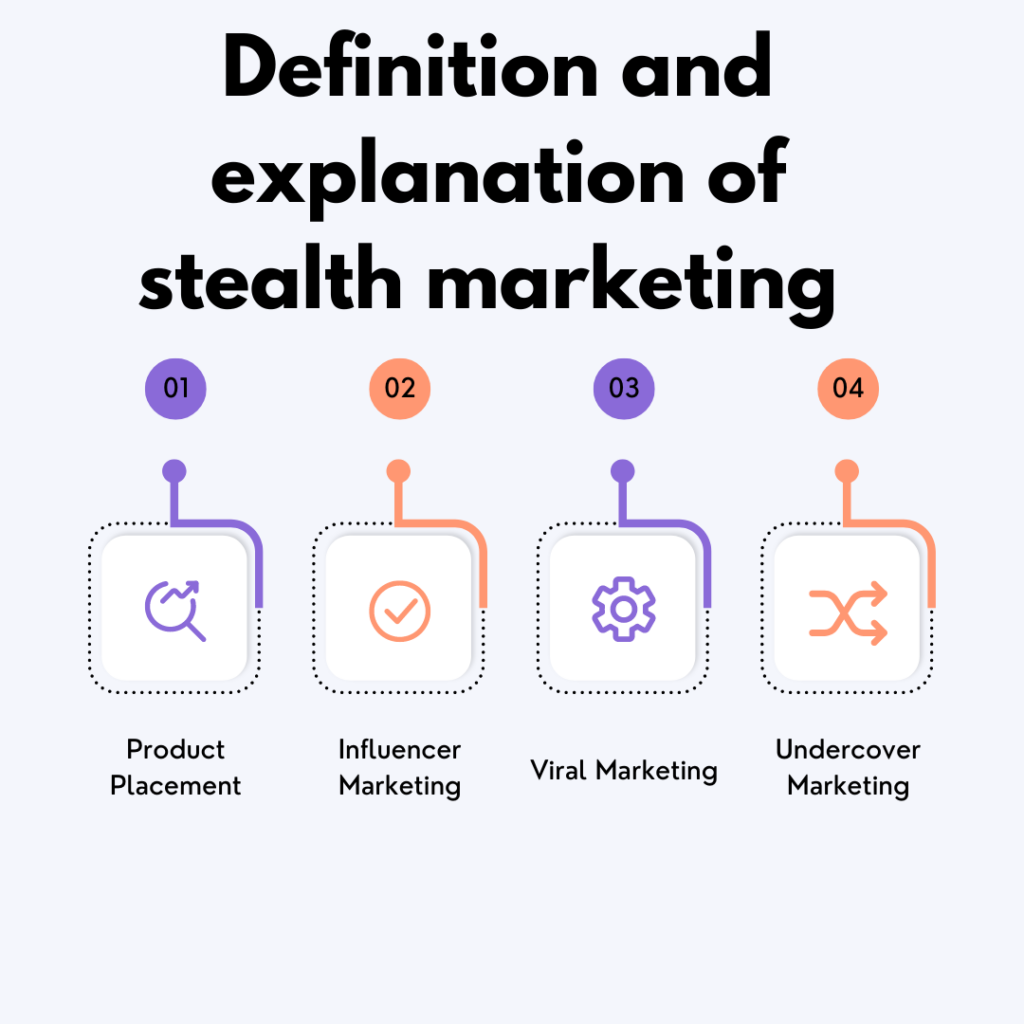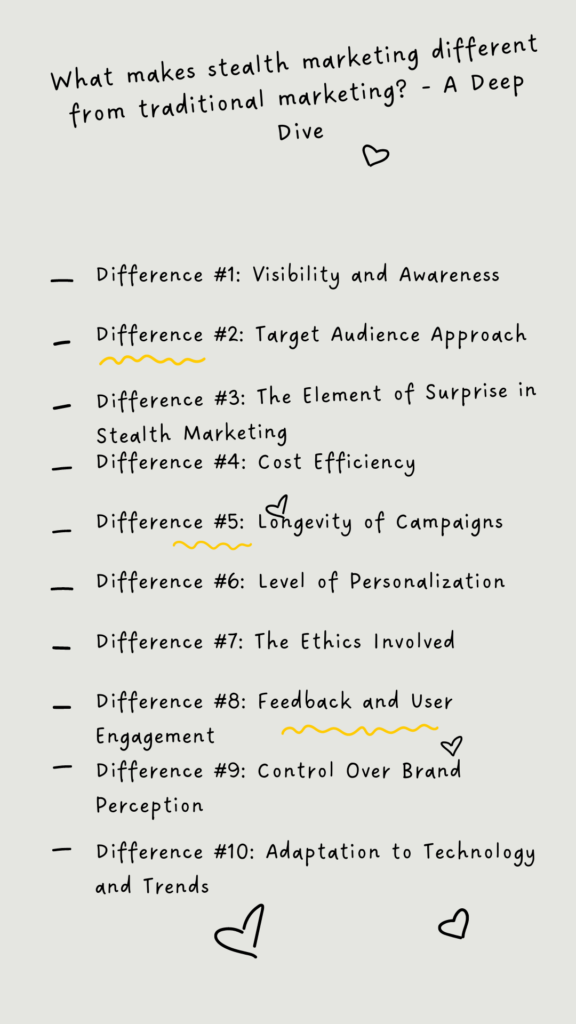What makes stealth marketing different from traditional marketing? A Tabulated Overview
| Feature | Stealth Marketing | Traditional Marketing |
| Approach | Subtle, indirect, aims to integrate product/service into everyday experiences | Overt, direct, uses recognizable advertising techniques |
| Consumer Awareness | Consumers may not consciously realize they are being marketed to | Consumers fully understand they are being exposed to advertising |
| Primary Techniques | Product placement, influencer marketing, buzz creation, undercover marketing, viral campaigns | Billboards, TV/radio commercials, print ads, direct mail, sponsored content |
| Trust Factor | Can build higher trust if done well, as it avoids feeling sales-driven | Can generate distrust or annoyance if perceived as pushy or manipulative |
| Cost | Often more cost-effective due to reliance on creativity over large ad budgets | Typically more expensive, requiring significant investment in ad production and media placement |
| Measurability | Can be harder to track concrete results, but often focuses on metrics like engagement rates, sentiment analysis, and brand resonance | Easier to track metrics like reach, impressions, conversions, and ROI |
| Flexibility | Offers greater flexibility in adapting to niche audiences and evolving trends due to its creative nature | May lack flexibility, as changes to campaigns can be time-consuming and expensive |
| Longevity | Can potentially have longer-lasting effects as it focuses on creating authentic connections with consumers | Campaigns may have a shorter lifespan and require constant refreshment to maintain effectiveness |
| Engagement | Often fosters deeper engagement as it relies on creating meaningful experiences rather than simple exposure | Engagement may vary depending on the creativity and effectiveness of the advertising content |
| Audience Response | Can evoke curiosity and intrigue, leading to a more positive response from audiences if executed well | Responses may be more immediate and measurable, but can also be more polarized depending on the impact of the advertising message |
Introduction to Stealth Marketing
Stealth marketing, often referred to as undercover or buzz marketing, is a strategy where consumers are unaware they are being marketed to. This strategy focuses on promoting a product, service, or brand without disclosing the intent of the campaign. Tactics involve product placements, viral marketing, experiential marketing, influencer marketing, and astroturfing.
Stealth marketing has its pros and cons. It can successfully generate organic interest and word-of-mouth advertising, as consumers are more likely to trust recommendations from peers, influencers, or their own discovery rather than blatant advertisements. However, the ethical implications of stealth marketing are a point of concern as its deceptive nature can lead to consumer mistrust if discovered.
Introduction to Traditional Marketing
Traditional marketing refers to the conventional methods used by businesses to communicate with their audience and sell their products or services. This includes print advertisements in newspapers and magazines, billboards, telemarketing, direct mail campaigns, and broadcast advertisements on television and radio.
Traditional marketing, due to its long standing history, has a proven track record of effectiveness. It can reach a wide audience and is particularly effective in local settings. Furthermore, the physical nature of many traditional marketing tools (like print ads or direct mail) can help engage consumers more deeply than digital equivalents. However, traditional marketing methods can often be more costly than digital alternatives, and measuring their impact can be more challenging.
Definition and explanation of traditional marketing
Traditional marketing refers to any type of promotion, advertisement, or campaign that has been in use by companies for years and has a proven success rate. It is a push strategy, which is about developing ways to bring the product or service to the customer.
Methods: Traditional marketing strategies include print advertisements in newspapers, magazines, and brochures, as well as direct mail, TV and radio commercials, billboards, and telemarketing.
Reach: Traditional marketing is often easier to reach local target audiences, as it uses offline media channels that traditionally have a local focus.
Tangibility: Traditional marketing provides a sense of legitimacy and gives consumers something tangible to reference or store.
Familiarity: Because of its historical usage, traditional marketing is often familiar to consumers and thus can build trust more quickly than newer, less familiar forms of marketing.
The importance and role of traditional marketing
Traditional marketing is important for several reasons.
Accessibility: Traditional marketing, through channels such as print and broadcast media, can reach millions of people who might not have access to digital media sources.
High retention: People tend to remember physical advertisements better as they engage multiple senses. For instance, a study by Millward Brown found that tangible materials leave a deeper footprint in the brain.
Credibility: Traditional marketing channels often offer perceived credibility, as they’ve been used and trusted by businesses and consumers for years.
Broad reach: Traditional marketing can reach a wide demographic, and is especially effective at targeting older generations that may not be as engaged with digital marketing strategies.
In terms of its role, traditional marketing:
Raises Awareness: Traditional marketing methods are highly effective at building brand awareness and attracting potential customers.
Increases Customer Trust: By appearing in established and reputable media outlets, companies can increase customers’ trust in their products or services.
Boosts Sales: By reaching a large audience and persuading them of the value of a product, traditional marketing can significantly boost sales.
Supports Other Marketing Efforts: Traditional marketing can also support digital marketing efforts by reaching those not reached by digital channels and pushing them towards online platforms for additional engagement.
Despite the rise of digital marketing, traditional marketing continues to play a vital role in reaching and persuading audiences, particularly those less engaged with digital channels. Its strategies and tactics have stood the test of time and continue to deliver results for businesses in various industries.
Definition and explanation of stealth marketing
Stealth marketing, also known as undercover or buzz marketing, is a strategy where products or services are promoted to consumers in a way that they do not realize they are being marketed to.
The key factor of stealth marketing is subtlety. It relies on indirect communication and less traditional marketing channels to reach potential customers. This can be achieved through strategies such as product placement, influencer marketing, viral marketing, and undercover marketing, among others.

Product Placement: This involves subtly placing products in movies, TV shows, or video games. The aim is to seamlessly integrate the product into the content so viewers may develop a positive association with the product.
Influencer Marketing: This entails leveraging influencers’ credibility to promote a product or service. Influencers, who have large followings on social media, subtly promote products in their posts in a way that seems natural and authentic to their audience.
Viral Marketing: This strategy involves creating content that is so engaging or unique that people naturally want to share it, thereby spreading the word about a product or service.
Undercover Marketing: This is a more deceptive form of stealth marketing. It involves marketers posing as regular people and subtly promoting a product or service in casual conversations or online discussions without disclosing their association with the company.
The Importance and Role of Stealth Marketing
Stealth marketing plays a significant role in today’s advertising landscape owing to the growing skepticism towards traditional advertising methods.
Overcoming Ad Avoidance: Many consumers employ techniques to avoid ads, such as skipping ads on YouTube or using ad blockers. Stealth marketing helps to overcome this by integrating the marketing message into content that consumers choose to engage with.
Building Trust: Stealth marketing often feels more authentic to consumers as it’s not overtly trying to sell something. This can help build trust and positive associations with the brand.
Reaching Target Demographics: Stealth marketing, particularly influencer marketing, can be an effective way to reach specific target demographics. Marketers can select influencers who align with their target audience’s interests and values, ensuring the message is delivered to the right people.
Driving Word of Mouth: Stealth marketing can be a powerful tool for generating word-of-mouth buzz about a product or service. This type of organic sharing is viewed as more credible and persuasive than traditional advertising.
While stealth marketing can be an effective tool, it’s crucial to use it ethically. Marketers should strive to be transparent and avoid misleading consumers. Stealth tactics that deceive consumers can lead to negative backlash and damage the brand’s reputation.
The Evolution from Traditional to Stealth Marketing
The Birth of Traditional Marketing
Traditional marketing was born in the early 20th century, with the surge of mass production and consumption. Companies needed a way to attract consumers to their products, and thus the concept of marketing was born. This involved newspapers, radio broadcasts, television advertisements, billboards, and direct mail campaigns.
The Rise of Digital Age:
The 1990s marked a significant transition in marketing due to the rise of the digital age. The internet allowed businesses to reach consumers in a new, more direct way. Websites, email marketing, and online advertisements became new platforms for marketing campaigns.
The Social Media Revolution
By the mid-2000s, social media platforms such as Facebook, Twitter, and Instagram evolved as powerful tools for marketers. They allowed businesses to connect with consumers on a personal level and in real time.
The Birth of Stealth Marketing
The late 2000s witnessed the birth of stealth marketing, a strategy that relies on subterfuge and deception to promote products. This was mainly due to consumers’ increasing skepticism towards traditional advertising methods and the desire for more authentic and personal connections with brands.
Factors That Led To The Evolution From Traditional Marketing to Stealth Marketing
Changing Consumer Behavior
One of the most significant factors in the evolution of marketing was changing consumer behavior. The digital age has made consumers more knowledgeable and discerning. They want authenticity and personal connections with brands, which traditional marketing often fails to deliver. This led to the rise of stealth marketing, which aims to engage consumers in a more subtle and personal way.
Technological Advancements
Technological advancements have played a crucial role in the evolution of marketing. The internet, social media, and smartphones have given marketers new platforms to reach and engage with consumers. These tools have also made stealth marketing possible.
Market Competition
Increased market competition has also contributed to the evolution of marketing. As the marketplace became more crowded, businesses had to find new and innovative ways to stand out. This led to the development of stealth marketing strategies, which aim to create buzz and generate word-of-mouth publicity.
Regulatory Environment
The regulatory environment has also influenced the evolution of marketing. As governments around the world have imposed stricter regulations on advertising, marketers have had to find more subtle ways to promote their products. This has led to the rise of stealth marketing, which often operates in the grey area of advertising regulations.
What makes stealth marketing different from traditional marketing? – A Deep Dive

Difference #1: Visibility and Awareness
Traditional marketing methods are generally high visibility and direct. They often involve mass media advertisements (TV, Radio, Print), direct mail, telemarketing, and outdoor advertisements that are easily identifiable by consumers. In contrast, stealth marketing is a less visible and more covert approach. It involves using unconventional methods to promote a product or service without directly revealing that the activity is a marketing campaign. It could involve tactics such as product placements, viral marketing, and undercover marketing.
Difference #2: Target Audience Approach
Traditional marketing often targets a broad audience with a one-size-fits-all message. However, stealth marketing often targets a specific, highly segmented audience. It works on the premise that each consumer segment responds differently to marketing messages, and therefore bespoke tactics should be employed to reach them effectively.
Difference #3: The Element of Surprise in Stealth Marketing
Stealth marketing aims at surprising consumers with a unique and memorable experience, unlike traditional marketing, which aims to inform and persuade consumers about a product or service directly and straightforwardly. Stealth marketing can lead to consumers discovering the product or service themselves, enhancing their interest and engagement.
Difference #4: Cost Efficiency
Given the often high costs associated with traditional marketing methods—such as TV commercials or billboard advertising—stealth marketing can be a more cost-efficient strategy. It often relies on word-of-mouth and viral sharing, which can generate high exposure at a lower cost.
Difference #5: Longevity of Campaigns
Traditional marketing campaigns often have a set start and end date. In contrast, stealth marketing campaigns can potentially have a longer lifespan, as they rely on consumers sharing and talking about the campaign, which can continue long after the initial promotional activity has ended.
Difference #6: Level of Personalization
Stealth marketing allows for higher levels of personalization. It uses tactics like influencer marketing, where a product or service is promoted in a way that feels organic and personalized to the influencer’s audience. In contrast, traditional marketing often uses a more generalized message intended to appeal to a broad audience.
Difference #7: The Ethics Involved
The covert nature of stealth marketing has raised questions about its ethical implications. Critics argue that it can deceive consumers by not clearly identifying itself as marketing. In contrast, traditional marketing methods are generally transparent and recognizable as marketing by consumers.
Difference #8: Feedback and User Engagement
Stealth marketing can stimulate more user engagement and feedback by creating a sense of mystery and intrigue. This encourages consumers to engage in speculation and discussion, generating buzz around the product or service. Traditional marketing, being direct and upfront, doesn’t usually stimulate the same level of engagement or discussion.
Difference #9: Control Over Brand Perception
With traditional marketing, businesses have more control over their brand perception since they create and broadcast the message directly. In stealth marketing, the control is more distributed. The consumers, influencers, or third-party platforms involved in the campaign can heavily influence the perception of the brand.
Difference #10: Adaptation to Technology and Trends
Stealth marketing is generally more adaptable to new technologies and trends, particularly social media and influencer marketing. Traditional marketing methods can be slower to adapt to new technologies and trends, often due to larger budgets and longer planning and execution times.
The Impact of Stealth Marketing versus Traditional Marketing on Consumers
How stealth marketing influences consumer decision-making
Concealment of Marketing Tactics: Stealth marketing’s primary strategy involves disguising marketing messages as unbiased information from a third-party source. This veil can obscure the commercial intent of the strategy, leading consumers to perceive the message as more credible and trustworthy. Consequently, consumers may be more likely to make purchasing decisions based on these covert endorsements.
Viral Potential: Stealth marketing often utilizes social platforms and influencer networks to spread messages. The viral nature of these platforms can significantly amplify the reach and impact of stealth marketing, compelling consumers to engage with or purchase a product due to perceived popularity or ‘trending’ status
Emotional Engagement: Stealth marketing often capitalizes on storytelling and experiential strategies to create emotional connections with consumers. This emotional engagement can significantly impact consumer decision-making as consumers are more likely to purchase products that they feel emotionally connected to
How traditional marketing influences consumer decision-making
Direct Information Provision: Traditional marketing provides direct, explicit information about products or services, which consumers use to compare and evaluate purchase decisions. Research shows that clear and straightforward messages can significantly impact consumer decision-making, particularly when consumers have explicit needs or preferences
Brand Image and Recognition: Traditional marketing also focuses on building and reinforcing brand image and recognition. This can highly influence consumers’ purchase decisions as consumers tend to prefer familiar brands and perceive them as safer and more reliable choices
Promotional Activities: Traditional marketing often involves promotional strategies like sales, discounts, and special offers. These can directly impact consumers’ perceived value of the product and stimulate immediate purchasing behavior
In the modern world, stealth and traditional marketing techniques often coexist and intertwine, creating a complex marketing environment. While stealth marketing can leverage the power of social influence and emotional engagement, traditional marketing remains effective in providing direct, clear information and enhancing brand recognition. Both approaches have unique advantages and can influence consumers in different ways, underlying the importance of their strategic use in marketing planning
Samrat is a Delhi-based MBA from the Indian Institute of Management. He is a Strategy, AI, and Marketing Enthusiast and passionately writes about core and emerging topics in Management studies. Reach out to his LinkedIn for a discussion or follow his Quora Page

